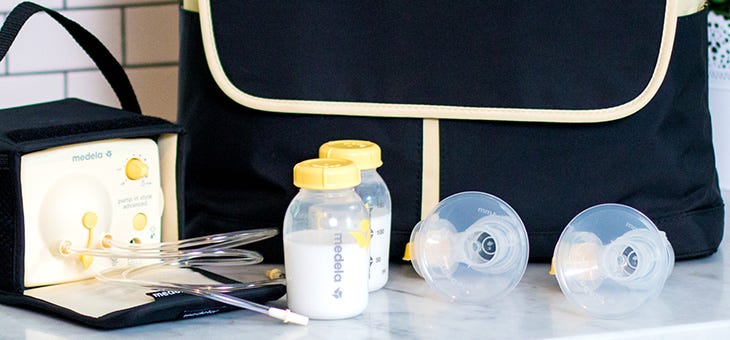

This fan would spin along with our washing chamber once all the wash and rinse cycles were completed to circulate the airflow. For this system, a fan was inserted onto the lid of our device. After the parts have been washed, the next focus is drying them. Initially, there were plans to develop a soap chamber where a cleaning agent reservoir could be integrated into the fluid system, but it was found that pouring the cleaning agent straight into the washing chamber would be easier. Drainage water is run into a sink drain, removing the need for a drain reservoir that must be emptied.

Once each cycle is done, the water will be drained out of the chamber by another pump.

Airflow breast pump series#
The device will then go through a series of washing and rinse cycles as it cleans the parts. Water is then injected into the side of the washing chamber. Selection of this heating unit was an important step, as it must heat the water up fast enough to satisfy our time related design requirements. Before the water enters the cleaning chamber, it will pass through a heating unit that heats up the water to 145 ℉. The current fluid system features a 5L reservoir that must be filled manually, but the prototype also has the capability to be attached directly to hot water lines, like those found on a sink. We have opted to use a pump system that will transfer water from a reservoir into the cleaning chamber. This is the system responsible for moving and heating water throughout the device. The next major subsystem of our prototype was the fluid subsystem. The footprint of the gearbox assembly is also less than the belt driven shaft, allowing more space for fluid and electronic components within the device. To prevent this from being the case, an aluminum case with soundproofing panels will be constructed around the subsystems of our device. As we are designing this device for an NICU setting, we need to ensure that the device does not produce sound exceeding the noise limit of 45 db. That said, our mechanical subsystem still makes noise even with the gear system design. These systems were often extremely loud and had issues when it came to smooth rotation. Previous iterations developed by past MSD teams opted to use a belt rather than gear system. Some reasons for going with this design include more consistent rotation, and less noise. For this design, we opted to use a gearbox assembly and motor shaft to achieve the basket rotation within the washing chamber. The mechanical subsystem of our prototype refers to the mechanisms that will allow the basket in the washing chamber to rotate. These include our mechanical subsystem, fluids subsystem, drying subsystem, and electrical subsystem. The design of our prototype has been broken down into three main subsystems. For our prototype, we have opted to construct a washing chamber with a rotating basket that will hold pump parts as they go through a cleaning cycle. Key constraints include budget, time (one academic year), and NICU standards. The cleaning system's new design should minimize the product's footprint, operate quietly, and provide a simple maintenance plan. The product should minimize time and effort that the mother would be spending by washing the parts by hand. The automated breast pump cleaning system should meet NICU standards for cleaning, sterilizing and drying the pump parts as effectively as hand-washing, within a 2-3 hour time window. The goal of our project is to create an automated system that will clean and dry the breast pump parts between each feeding. Currently, there are no other systems that clean every part of a breast pump without the need of outside resources such as a scrub brush and microwave. New parents and caregivers in the NICU are under constant stress about the health and safety of their newborn which leaves them little energy to thoroughly clean their breast pump parts after each use. Currently, mothers in the NICU have to wash their breast pump parts after every feeding, this takes time and energy. Breast pumps allow mothers to feed their babies and produce milk while they are unable to feed directly from their breasts. Mothers are currently recommended to pump their breast milk between eight and twelve times a day, which becomes difficult pretty quickly. Mothers with babies in the NICU are recommended to provide breast milk for their child, as it provides vital nutrients, enzymes, and antibodies needed for the growth and development of their newborn. Newborn babies who are born prematurely or with an illness will stay in the Neonatal Intensive Care Unit (NICU), in the hospital.


 0 kommentar(er)
0 kommentar(er)
